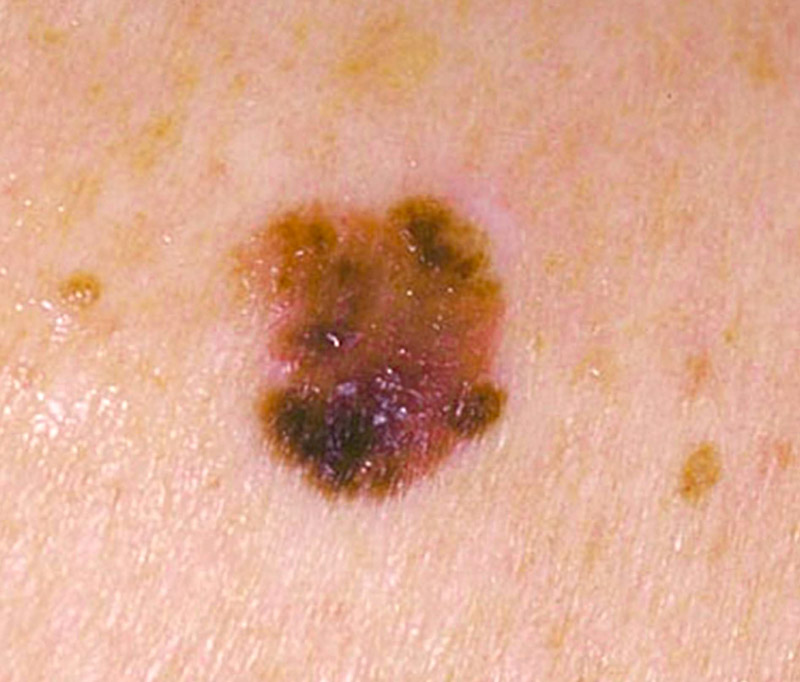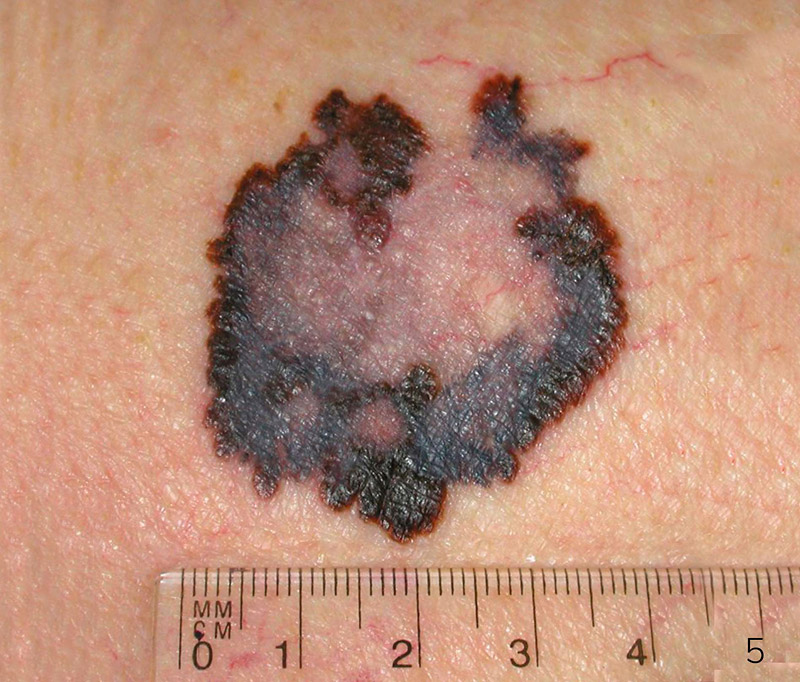Early detection is vital as, if caught early, 90% of melanomas can be cured with surgery.
It is important to ‘know the skin you’re in’ and seek medical advice if you notice anything new or changing on your skin. The first sign of a melanoma is often the appearance of a new spot, or a change in an existing freckle or mole.
Remember, melanomas are not always black – they can also be brown, pink, skin coloured or a combination of different shades.
The ABCDE guidelines provide a useful way to monitor your skin. Seek medical advice if you notice any of the following:

A is for ASYMMETRY:
One-half of a mole or birthmark does not match the other.

B is for BORDER irregularity:
The edges are irregular, ragged, notched, or blurred.

C is for COLOUR variation:
The colour is not the same all over, but may have differing shades of brown or black, sometimes with patches of red, white, or blue.

D is for DIAMETER:
The area is larger than 6mm (about the size of a pencil eraser) or is growing larger.

E is for EVOLVING:
Changes in size, shape, colour, elevation, or another trait such as itching, bleeding or crusting. This last point is likely the strongest of all of the warning signs.
How do I make sure I don’t miss anything?
- Stand in front of a full length mirror in a well lit room.
- Start at the top and work your way down your body.
- Begin by using a brush or hairdryer to part your hair into sections so that you can check your scalp.
- Move to your face and neck, not forgetting your ears, nostrils and lips.
- Be sure to check both the top and underneath of your arms. Don’t forget your fingernails.
- As you move down your body don’t forget to check places which may never have seen much sun. Melanoma can be found in places that do not have exposed skin.
- Ask a partner or family member to check your scalp and back.
- The best way to monitor changes on your skin is by taking photographs every few months and comparing them to identify any changes. React quickly and seek medical advice if you see something growing and/or changing.
Professional skin checks
It is important to get a professional skin check by a GP or dermatologist if anything suspicious appears on your skin or if you are high risk. Talk to your doctor about if and how often you should be getting a regular professional skin check.
Doctors use a number of tools and techniques to examine skin thoroughly, beyond what the naked eye can see. These include dermoscopy using a dermatoscope (see photo), digital monitoring and total body photography. These tools help reduce unnecessary biopsies and can detect melanomas at an early stage.
Who to see:
General Practitioner (GP)
A GP can perform a skin check and examine any lesions of concern. They are familiar with your history, can talk to you about risk factors and family history, and treat some skin cancers. They might also refer you to a dermatologist, if needed.
Skin Cancer Clinics
There are many skin cancer clinics across Australia. Skin cancer clinics are usually operated by GPs with a focus on skin cancer. Many clinics offer the latest technology for examining skin spots.
You can search for a skin check doctor here.
Dermatologists
For people at high risk of melanoma, or for specialist advice, a referral to see a dermatologist may be recommended. Dermatologists are doctors who have completed additional training to specialise in diagnosing and treating skin disease, including skin cancers. To see a dermatologist, you will need a referral from a GP or a skin cancer clinic.
MIA has a Melanoma Dermatology clinic in The Poche Centre at Wollstonecraft Find out more.

Skin check apps
Several smartphone apps allow you to photograph your skin and set reminders for skin checks. They can be really helpful for keeping track of your moles over time, making it easier to detect changes. However, they cannot reliably diagnose skin cancer and should not replace a visit to the doctor if you find something you are concerned about.
National Targeted Skin Cancer Screening Program
Skin checks are an important tool in the early detection of skin cancers. MIA and others in the Australian skin cancer community have advocated for a more systematic, targeted and equitable approach to skin cancer screening. As a result, the Australian Govt has allocated $10m for the development of a Roadmap for a National Targeted Skin Cancer Screening Program.